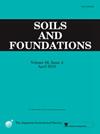石柱基础加固方法试验分析
IF 3.3
2区 工程技术
Q2 ENGINEERING, GEOLOGICAL
引用次数: 0
摘要
土工合成增强石柱可以显著改善软弱地基。虽然以前的研究主要集中在垂直或水平加固的单个影响上,但两者对石柱基础性能的综合影响仍然知之甚少。通过物理模型试验,研究了各种加固方法对石柱基础承载力和变形特性的影响,重点研究了组合加固对石柱基础承载力和变形特性的影响,弥补了这方面的研究空白。本研究包括不同的加固长度,水平加固间距和加固方法的组合。试验结果表明,土工合成材料能有效地限制石柱基础的径向变形,提高地基承载力。随着加固间距的减小和加固长度的延长,其承载能力有所提高。在本研究测试的所有加固类型中,全长(L)垂直加固的影响最为显著。此外,研究还考察了石柱内部的应力传递和侧应力分布,发现随着荷载的增加,石柱基部应力与侧应力的比值增大,侧应力在距地表2.5D深度处达到峰值。这种行为与模型试验中观察到的变形模式一致。本文章由计算机程序翻译,如有差异,请以英文原文为准。
Experimental analysis of reinforcement methods for stone column foundations
Geosynthetic-reinforced stone columns can significantly improve weak foundations. While previous studies have focused on the individual effects of vertical or horizontal reinforcement, the combined influence of both on stone column foundation performance remains poorly understood. Through physical model tests, this study investigated the effects of various reinforcement methods on the bearing capacity and deformation characteristics of stone column foundations, with a particular focus on the combined reinforcement in enhancing their performance, addressing this research gap. This study encompasses different enhancement lengths, horizontal reinforcement spacings, and combinations of reinforcement methods. Experimental results demonstrate that geosynthetics significantly limit radial deformation and improve the bearing capacity of stone column foundations. Notably, the bearing capacity increases with reduced reinforcement spacing and extended enhancement length. Among all the reinforcement types tested in this study, the full-length (L) vertical reinforcement demonstrated the most significant impact. Additionally, the study examines stress transfer and lateral stress distribution within the stone columns, revealing that as the load increases, the stress ratio at the stone column base and lateral stress rises, with lateral stress peaking at a depth of 2.5D from the surface. This behaviour aligns with the deformation patterns observed in the model tests.
求助全文
通过发布文献求助,成功后即可免费获取论文全文。
去求助
来源期刊

Soils and Foundations
工程技术-地球科学综合
CiteScore
6.40
自引率
8.10%
发文量
99
审稿时长
5 months
期刊介绍:
Soils and Foundations is one of the leading journals in the field of soil mechanics and geotechnical engineering. It is the official journal of the Japanese Geotechnical Society (JGS)., The journal publishes a variety of original research paper, technical reports, technical notes, as well as the state-of-the-art reports upon invitation by the Editor, in the fields of soil and rock mechanics, geotechnical engineering, and environmental geotechnics. Since the publication of Volume 1, No.1 issue in June 1960, Soils and Foundations will celebrate the 60th anniversary in the year of 2020.
Soils and Foundations welcomes theoretical as well as practical work associated with the aforementioned field(s). Case studies that describe the original and interdisciplinary work applicable to geotechnical engineering are particularly encouraged. Discussions to each of the published articles are also welcomed in order to provide an avenue in which opinions of peers may be fed back or exchanged. In providing latest expertise on a specific topic, one issue out of six per year on average was allocated to include selected papers from the International Symposia which were held in Japan as well as overseas.
 求助内容:
求助内容: 应助结果提醒方式:
应助结果提醒方式:


